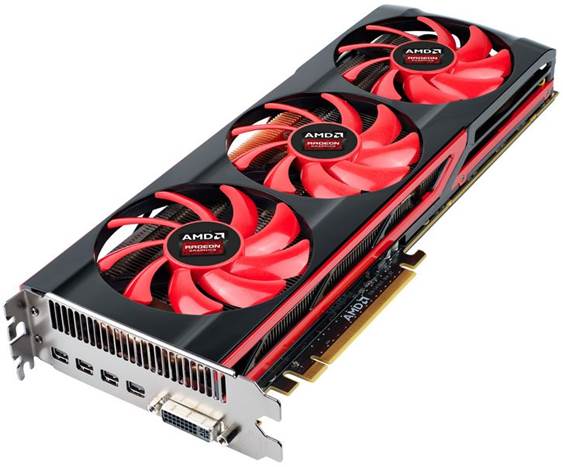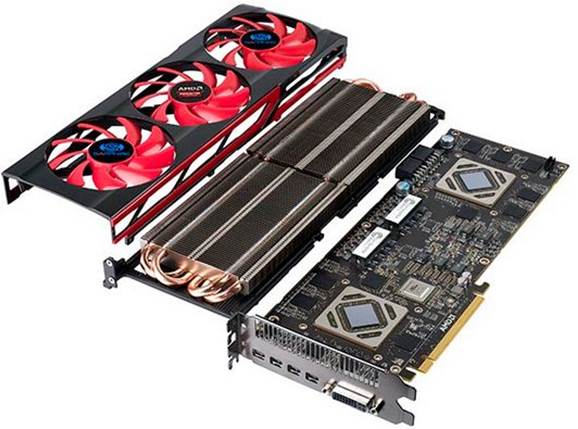Ever since the release of the Radeon HD
3870 X2 way back in early 2008, AMD has released a dual-GPU video card (i.e.
two graphical processing chips on one physical card) comprised of two of its most
powerful chips with each GPU generation.
This time around it's the monster Radeon HD
7990 (formerly codenamed 'New Zealand') gracing us with its presence, which is
comprised of two powerful HD 7970 processors and 6GB of high speed GDDR5
memory.

As
per usual, the two GPUs are connected via an onboard PLX Crossfire bridge so
for all intents and purposes it appears as a single video card to both the user
and their PC.
As per usual, the two GPUs are connected
via an onboard PLX Crossfire bridge so for all intents and purposes it appears
as a single video card to both the user and their PC.
Despite having a recommended retail price
of $1,499, at time of writing I struggled to find one listed in New Zealand for
under $1,800, and stock was incredibly thin on the ground with only a handful
of stores having a couple on the shelves.
Compared to its predecessor, the HD 6990
which launched over two years ago at approximately $1,300, the HD 7990 has 33%
more processor units (2048 on each GPU), a full gigahertz bump in memory speed
(to 6GHz) running on wider memory bus (384- bit, up from 256-bit), as well as
being built on the newer and more efficient 28nm GCN (Graphics Core Next)
architecture.
You'll need two 8-pin PCIE connectors to
feed up to 375W into the triple-fan-cooled HD 7990, along with ample room in
your case to accommodate its 31cm length.
The core clock speed of each GPU in the HD
7990 is 950MHz (up to iGHz with Boost enabled) which falls squarely in between
the standard HD 7970 and the 'GHz Edition' HD 7970. In all other respects, it
literally is two HD 7970s on one circuit board with all the standard HD 7900
series features such as Eyefinlty2.0, HD3D, ZeroCore, PowerTune and AMD Stream
technologies.

The
core clock speed of each GPU in the HD 7990 is 950MHz (up to iGHz with Boost
enabled) which falls squarely in between the standard HD 7970 and the 'GHz
Edition' HD 7970.
The AMD reference model we received for
testing didn't come with any retail packaging or software, however according to
AMD, purchasers of the HD 7990 will receive 8 coupons to download popular games
such as Crysis 3 and Bioshock Infinite.
In terms of competition at the moment, the
HD 7990 faces a fairly crowded marketplace in the enthusiast segment with the
Nvidia GTX 690, GTX 780 and GTX Titan all packing $1,000+ price tags.
As far as raw performance goes, the HD 7990
bounced all over the GTX Titan in our tests with almost 15% higher FPS at 1920
X 1080, extending to roughly 20% in the multi-monitor 5040 x 1050 tests
(although this comes at a cost of almost 200W extra system power).

Overall
the HD 7990 is the most powerful video card we have ever had come through the
PC World labs, period.
What's not shown in these statistics
however are the minor graphical glitches, stutters and anomalies which have
become synonymous with multi-GPU setups. Some games were fine and the rest only
suffered from minor issues - e.g. light, shadows or geometry briefly flickering
out of place - but if you're pedantic about these things it's something to be
aware of.
Overall the HD 7990 is the most powerful
video card we have ever had come through the PC World labs, period. Personally
I think it is poor value for money (it costs 50% more than buying two HD 7970s
separately) but if your trust fund can cope then I heartily recommend it.
|
At a glance
·
AMD's flagship dual-GPU PCIE3.0 Video Card
·
Needs a lot of power, space, and funds
·
Chart-topping performance, albeit with minor
glitches
·
Poor value compared to buying two identical
single-GPU cards
AMD Radeon HD 7990
·
RRP incl GST: $1,499 ($1,799 retail at time of
writing)
·
Contact: amd.com
·
3.5/5
·
A big, expensive, power-hungry video card that
churns out the frames like no other.
|